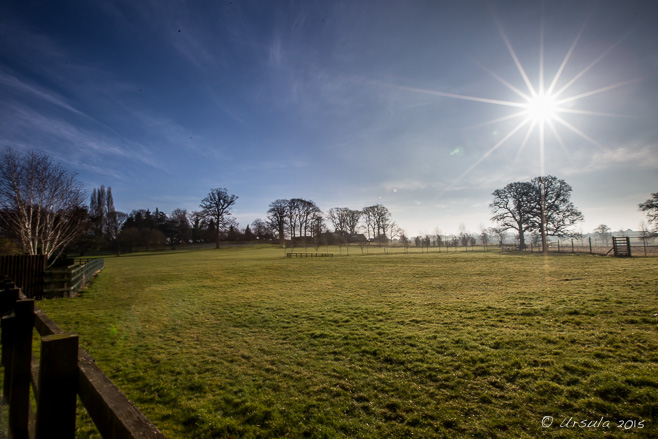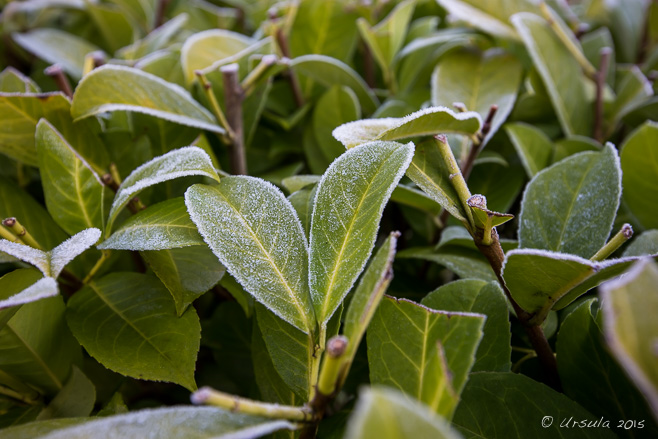
Morning over St Mary’s Asylum
Another English winter day breaks cold and clear as a sun with little warmth rises over the public greens at Burghill.
It’s no surprise that every Brit, regardless of age or gender, owns at least one pair of gumboots or wellingtons. You can’t get far in the English countryside without them.
Winter in England has a reputation: grey and bleak and wet.
While it is true that the whole time I’ve been here, it has been wet, at least under-foot (hence the need for rubber boots), everyday has offered at least some sunlight and blue sky. It has been a pleasure walking past the fallow fields on country lanes and roads, past thickets and hedgerows and copses – such British words – alive with the chirping of small birds.
On a recent Sunday walk in Herefordshire, West Midlands, I encountered stretches of ice, puddles of water, expanses of frost, a small patch of snow, and a whole lot of mud. I was thankful for my new rubber boots at every step.
In spite of the vagaries of the terrain – and the dangerous blind corners on roads with no shoulders or verges, bounded by brambles and hedges so there is no escape from the pavement – it was a pleasant walk from my bedsit in one of the renovated buildings around St. Mary’s (Psychiatric) Hospital, Burghill (established as Hereford County and City Lunatic Asylum in 1868) to Credenhill Park Woods, site of a 2000+ year old Iron Age hill fort…
Every little corner of England is layered with history – ancient and modern.

Morning Frost
There is frost in the hedges and black-ice underfoot: it’s a cold February morning in Hereford.
Snow on the Brecon Beacons
Once out of the St Mary’s housing estate, there are view over Bakers Furlong farmlands and all the way to the mountains of South Wales.

Public Footpath to Burghill?
Footpaths and bridle paths can be found all around the countryside. The trouble is that the signposting leads into unmarked fields, and without a proper ordnance map or local knowledge it is not clear where the path is meant to go and where the gate out of the field might be found.

Burghill Farm
Growing frames wait for the new season.

Fallow Fields
The winter fields are cut down and plowed over.

Herefords
The popular and hardy Hereford beef cattle, now found in over 50 countries, were bred right here in Herefordshire.

Manor House
The hill that comprises Credenhill Park Wood rises up from the surrounding estates and farmlands…

Credenhill Street
… as the road winds around the base into the outskirts of Credenhill village.

“Old Cottage”
This charming English-Heritage Listed timber-framed cottage with a traditional thatched roof was built in the late 17th or early 18th century, with some later modifications.

Snowdrops
Small signs of spring rise up out of the dirt and litter at the side of the road.

Winter Fields
Muddy roads lead off across the fields in all directions.

Horses in the Park
Credenhill Park Wood is a 90-hectare (223-acre) woodland in the Hereford Hills near the village of Credenhill. One of the paths around the ancient semi-natural woodlands is available to specially-licenced horse riders.

Leaf Litter
Steep side-trails that lead between the main trails are muddy and covered in fallen leaves.

Winter Woods
It’s dark in the woods: a thin afternoon sun angles through the thick trees. The park is a mix of native broadleaf trees and non-native conifers that were introduced over the years for commercial purposes.

Fort?
Deep in the woods, there is a fort of some sort in a small clearing.

Open Plateau
Some of the land at the top of the hill has been cleared, allowing 360° views over the countryside. A covered picnic table probably gets more use in warmer weather.

On the Ramparts
The path around the top of the hill fort ramparts may be passable, but it is slippery and rough with tangled roots.

Under the Ancient Yews
The hill fort was built more than 2000 years ago, during the Iron Age. Excavations around the defensive earthworks have given some insight into how it was constructed. An explanatory signboard sits under the branches of a three-hundred year old yew tree.

Stairs
Steep stairs lead up and down the ancient ramparts, which still rise to over 10 metres high in places.

Holly

Ivy

Into the Woods
The woods are a dense mix of broadleaf trees (beech, ash, and hazel) and non-native conifers.

Livestock Enclosure
Part of the hill is fenced off for stock grazing.

Wild Clematis
Back on the roadway outside the woodlands, wild clematis winds around the winter hedges along the roadside…

Tree on the Road
… and trees without leaves stand tall against the afternoon sky.
There is life in the English winter woods: I saw plenty of birdlife, including three pheasants that whooshed over my head when I startled them. Squirrels and rabbits are never far away.
It’s a lovely place for walks – as long as you dress warmly, and pack an umbrella just in case…
 – and wear your rubber boots.
– and wear your rubber boots.
Till next time ~
Happy Rambles!
Pictures: 08February2015
































.png)


Holly. Ivy. But no Poppy. What’s up with that!?
Take care!
😎
Ha Ha Thomas!
Plenty of Poppy on FaceBook. 😀
[…] Hills … on other days, I donned gumboots and ventured into the hills and countryside (see: Credenhill Wood). (08February2015, Canon EOS 5D […]